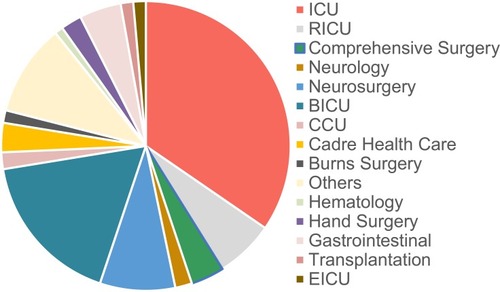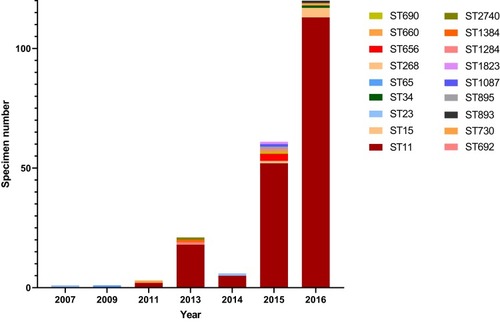Figures & data
Table 1 Collection Summary of CRKP from 2003 to 2016
Figure 1 Distribution of CRKP isolations in terms of patient sample and ward. (A) The distribution of specimen types which 214 CRKP were isolated from was plotted as pie charts. (B) The distribution of specimen source in this hospital was plotted as pie charts. (C, D) Time distribution of the various patient sample type or the ward of the hospital from which it was sampled. Since few CRKP isolates were identified in 2007, 2009 and 2011, the clinical information of these were analyzed together.
Abbreviations: ICU, intensive care unit; BICU, brain intensive care unit; RICU, respiratory intensive care unit; CCU, cardiac care unit; EICU, emergency intensive care unit.

Figure 2 Clonal types of 214 CRKP in a hospital in Wenzhou, 2003–2016. For MLST-based categorization of these strains, the sequences of seven housekeeping genes (i.e., gapA, infB, mdh, pgi, phoE, rpoB, and tonB) were analyzed, and the ST pattern of each year was showed by colored band, which represented the difference in numbers. No CRKP were identified from 2003 to 2006.
Abbreviation: ST, sequence type.

Figure 3 Longitudinal analysis of 214 CRKP isolates. Time distribution of antimicrobial susceptibility profiles of CRKP isolates. The “non-sensitive rate” is calculated by dividing the amount of non-sensitive (i.e., includes resistant and intermediate) by the total isolates in each year. (A) The non-sensitive rate of ATM, CAZ, CRO, TZP and SAM, which maintain 100% resistance from 2003 to 2016. (B) The non-sensitive rate of CIP, FEP and LVX, which possessed an increasing trend during this period. (C) The non-sensitive rate of SXT, GEN and TOB, which show a dynamic change. Since few CRKP isolates were identified in 2007, 2009 and 2011, the clinical information of these were analyzed together.
Abbreviations: ATM, aztreonam; CAZ, ceftazidime; CIP, ciprofloxacin; CRO, ceftriaxone; FEP, cefepime; GEN, gentamicin; LVX, levofloxacin; TOB, tobramycin; TZP, piperacillin/tazobactam; SAM, ampicillin-sulbactam; SXT, trimethoprim-sulfamethoxazole.

Table 2 The Carrier Rates of Virulence Factors in CRKP from Blood Samples Among Different Outcome Groups
Table 3 The Carrier Rates of Virulence Factors in CRKP from Blood Samples Isolated Across 2007 to 2016
